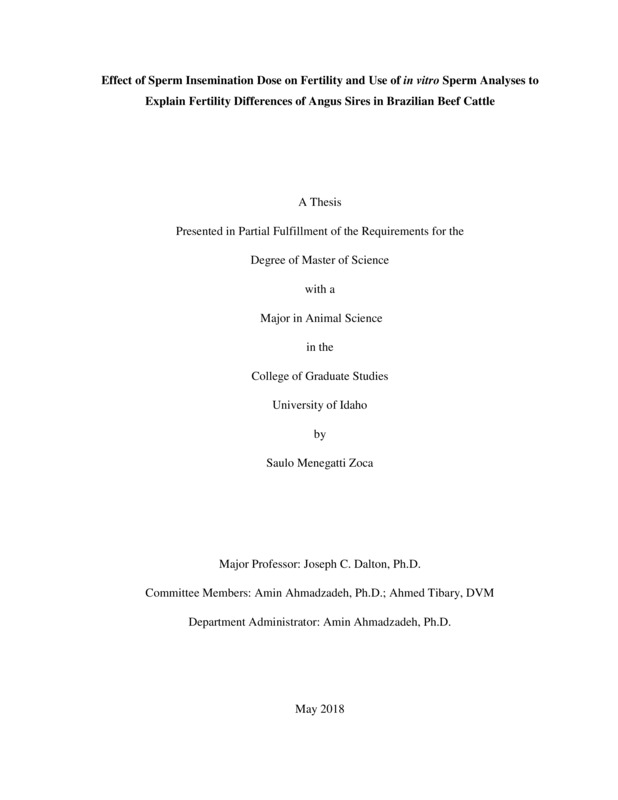Effect of Sperm Insemination Dose on Fertility and Use of in vitro Sperm Analyses to Explain Fertility Differences of Angus Sires in Brazilian Beef Cattle
Menegatti Zoca, Saulo. (2018-05). Effect of Sperm Insemination Dose on Fertility and Use of in vitro Sperm Analyses to Explain Fertility Differences of Angus Sires in Brazilian Beef Cattle. Theses and Dissertations Collection, University of Idaho Library Digital Collections. https://www.lib.uidaho.edu/digital/etd/items/menegattizoca_idaho_0089n_11375.html
- Title:
- Effect of Sperm Insemination Dose on Fertility and Use of in vitro Sperm Analyses to Explain Fertility Differences of Angus Sires in Brazilian Beef Cattle
- Author:
- Menegatti Zoca, Saulo
- ORCID:
- 0000-0002-5272-9405
- Date:
- 2018-05
- Embargo Remove Date:
- 2020-11-15
- Keywords:
- bull compensable traits fertility sperm analyses sperm dosage uncompensable traits
- Program:
- Animal and Veterinary Science
- Subject Category:
- Animal sciences
- Abstract:
-
The objectives of the first study were, primarily, to determine if beef bull fertility varied by number of sperm inseminated and, secondarily, to characterize the potential impact of random variation through the use of two identical sperm per dose treatments, which differed only by straw color. In the second (in vitro) study, the primary objective was to identify sperm characteristics associated with fertility differences between bulls from the field fertility trial. A secondary objective was to investigate the pattern and variability of in vitro sperm characteristics using principal component analysis. In the first study, although fertility differences between bulls were detected, fertility following timed artificial insemination with 10, 20, 20 or 40 × 106 sperm per dose resulted in a similar proportion of cows pregnant per timed artificial insemination (P/TAI) at first service in synchronized beef cattle. Although the overall P/TAI between the two control groups (20 × 106 sperm per dose) were not different, the numerical variation within bull ranged from 0.5 to 4.9 percentage points, providing evidence that variation in reproductive field trials should not be ignored. In the second study, morphologic evaluation, computer-assisted sperm analysis and flow cytometry were not able to explain the difference in field fertility between bulls. Principal component analysis simplified the complexity of data from computer-assisted sperm analysis and flow cytometry and allowed for the identification of key sperm characteristic variables. The use of principal component analysis should be investigated further, as it allows for the grouping and identification of key sperm characteristics, and provides a visual aspect to understanding variability.
- Description:
- masters, M.S., Animal and Veterinary Science -- University of Idaho - College of Graduate Studies, 2018-05
- Major Professor:
- Dalton, Joseph C.
- Committee:
- Tibary, Ahmed; Ahmadzadeh, Amin
- Defense Date:
- 2018-05
- Identifier:
- MenegattiZoca_idaho_0089N_11375
- Type:
- Text
- Format Original:
- Format:
- application/pdf
- Rights:
- In Copyright - Educational Use Permitted. For more information, please contact University of Idaho Library Special Collections and Archives Department at libspec@uidaho.edu.
- Standardized Rights:
- http://rightsstatements.org/vocab/InC-EDU/1.0/

